Find out more.
GCSE predictions: what are the chances?
On a scale of 1 to 10, how useful would it be to have a clear (even a pretty clear) idea of what grades your students are likely to get in the new GCSE exams? In any of the subjects they might take?
Student outcomes can’t be predicted with total, absolute, 100% certainty. Let’s face it; there is a lot that can happen between the ages of 11 and 16.
However, it is possible to predict their chances of achieving certain grades.
The ‘Chances Graphs’ from the MidYIS assessment tell us how likely your students are to get certain grades in each of their GCSE exams. Combined with professional judgement and careful monitoring along the way, the chances graphs are a powerful tool that can give students a better chance of achieving their best.
Megan
Megan started Year 7 in September. She is a reserved student who seems to have found it difficult to adjust to her new school. She has a tendency to be quiet and work slowly, often not completing tasks and not engaging in classroom discussion.
Additionally, Megan’s records from primary school are patchy and her new teachers were initially uncertain about what level she was working at.
We know that it’s crucial that schools establish a clear baseline as soon as students enter school, so that individual gaps in learning can be identified and addressed.
Megan sat the MidYIS assessment a few weeks after starting her new school. MidYIS is not a test. It doesn’t examine what students have been taught previously or what they should know.
MidYIS is an assessment which evaluates each student’s starting point (no need to rely on inconsistent KS2 results) and provides a standardised, benchmark score in 4 crucial areas: Vocabulary, Mathematics, Non-verbal ability and Skills.
There is a strong relationship between students’ MidYIS scores and the grades they go on to achieve at GCSE. The MidYIS assessment has been taken by tens of thousands of pupils and we can link each student’s MidYIS score and their subsequent GCSE grades.
Predictions for GCSEs
Research shows that the four areas assessed by MidYIS are linked to later academic outcomes.
The MidYIS GCSE Predictions Table gives schools accurate predictions of the points students are most likely to achieve in all subjects, as well as showing the percentage chances of achieving certain points in each exam.
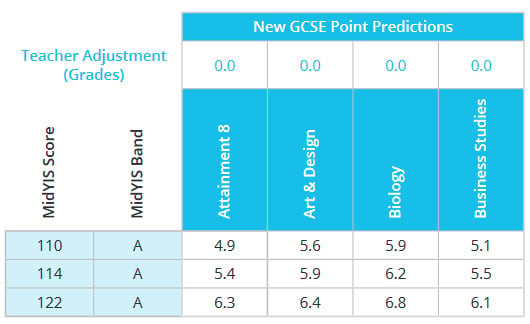
Good news for Megan: the MidYIS Individual Chances Graphs show that if Megan continues to respond well to academic challenges, in line with most other students with the same baseline score, the score she is most likely to achieve in GCSE Maths exam is a 6 (for IGCSE this would equate to a 'B' grade).
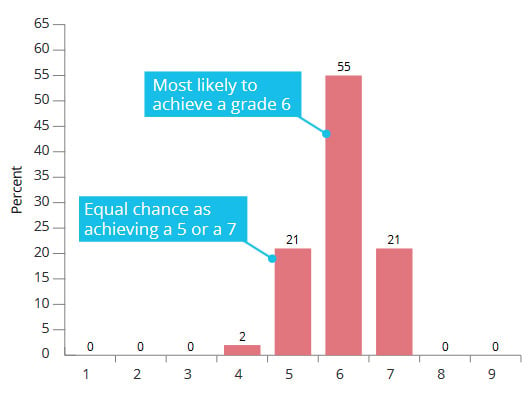
Attainment 8
Additionally, the Summary Chances Graphs show the probability of Megan’s achieving various grades in the whole range of subjects available – including an Attainment 8 score and scores for GCSES, short courses and vocational qualifications.
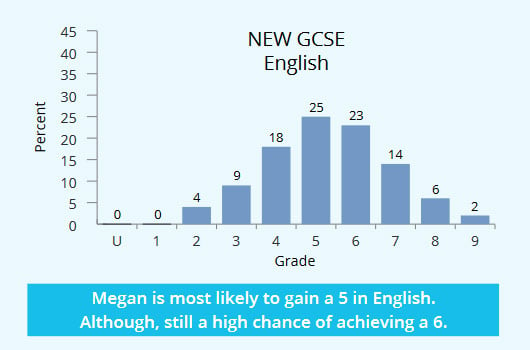
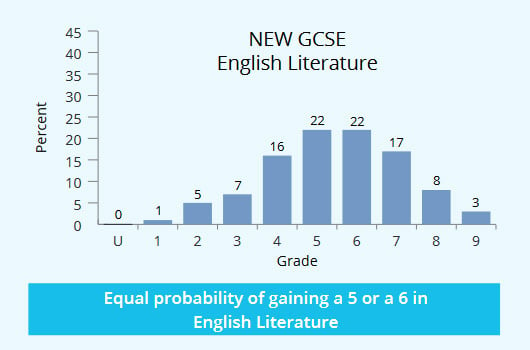
Being given a clear picture of Megan’s chances means that she and her school know how high they should be aiming, how they can help her most effectively and where she may need additional support.
Encouragement, motivation and choice
The MidYIS predictions to new GCSEs and chances graphs provide vital, forward-looking information which can help teachers, parents and students:
- To set realistic and challenging targets
- To motivate and encourage
- To guard against complacency
The predicted grades are not set in stone or a foregone conclusion and cannot be used to label students. They indicate an expected outcome based on a statistical prediction.
Used in conjunction with professional judgement and regular monitoring, the range of MidYIS feedback can help students to stay on track, to inform their decisions about what subjects to take at GCSE, as well as help parents get a realistic picture of what their child is likely to achieve.
Looking at the whole picture
A range of factors influence school and student performance, and key elements include the quality of teaching and leadership; the professional development of teachers; and the effective use of data.
School inspections and exam results provide an accountability framework for schools, and therefore, schools need robust measures to take account of the contribution schools make to student outcomes.
The MidYIS feedback provides school-level predictions in key stage 3, GCSE subjects and Attainment 8, helping subject coordinators, school leaders and governors get an idea of the expected performance across the whole cohort.
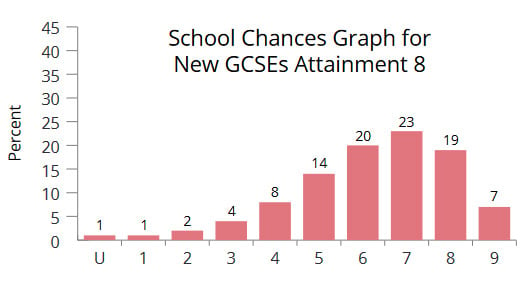
The school-level chances graphs summarise likely overall performance in each subject and can be used to:
- Aid school inspections
- Inform governance discussions
- Assist in school improvement planning
- Standardised baseline scores in order to benchmark Year 7 pupils and identify learning needs
- Objective predictions to the new GCSE exams to help teachers set challenging and realistic targets, and make sure pupils are given their best chance for success
- Robust, evidence-based value-added progress measures to evaluate school performance over time
Want to know how Cambridge Insight data can help in your school?
Find out more about our assessments

